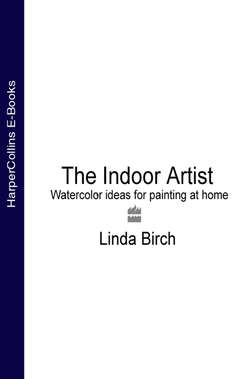Читать книгу The Indoor Artist - Linda Birch - Страница 8
A PLACE OF YOUR OWN
ОглавлениеA Place to Work
24 × 32 cm (91/2 × 121/2 in)
Every artist needs a permanent place to work with a desk, a chair and a lamp. Working materials can be left out ready to use – and to act as a subject, too.
Everyone who paints needs a place of their own to do it in. It is not easy if you need to clear the dining-room table every time you want to paint and then tidy your equipment away before the next meal. You must have a place to work, to think and to make a mess! Creativity is not a neat affair that can be set up and tidied away at the end.
You don’t need a large studio for the purpose – a corner of a spare room and a large table will do, just so long as it is your place where you can be left alone to work out your creative ideas.
ORGANIZING YOUR SPACE
Consider the options your home affords you for a dedicated work space. You may be fortunate enough to be able to take over a spare bedroom and turn that into your studio. However, if you have only the corner of that spare bedroom don’t despair – there are many ways of combining living and working spaces today, and rooms are often dual-purpose.
You will need a worktable of some sort. This doesn’t have to be a fancy affair, and if you are really short on funds you could consider buying a cheap wallpaper-pasting table from your local DIY store. They are large, practical and cheap, and fold away if you need to store them. One of these sufficed very well as my own first worktable.
Try to arrange your table near a window to catch the light, although the traditional north light is not really necessary. Even if you are working from a subject that needs a constant light direction, daylight bulbs, which can be easily obtained, will do the trick. I prefer to use a spotlight desk lamp to light my still-life groups or flowers. It gives warmth and vibrancy to the colours, whereas daylight bulbs are cooler in hue.
Make sure you have a comfortable chair to sit on while you work at your table. A typist’s chair, which can be bought cheaply from suppliers of second-hand office furniture, will be useful for its adjustable height control, which is vital to avoid developing a bad back. When sitting for long periods I find a footrest useful, which in my case is simply an old box.
Having a place of your own with all that you need laid out in readiness will make it easier to take up your work when you have only a short time available.
Try to position your table near a window to get the benefit of maximum natural light.
Practical considerations
If you don’t have any spare cupboard space, a small trolley with several baskets designed to hold vegetables makes good (and cheap) mobile storage. You can place sheets of paper under a spare bed to keep them flat and out of harm’s way, and other items you need such as a water jar and inks, spare still-life material and books can be stored on an overhead shelf.
When you are working for long periods of time in one spot, you may need to provide extra warmth. If you only need to keep the specific area you are sitting in warm, consider using a safe form of heating such as an oil-filled radiator which is sealed and can be wheeled to where you want it. It is not advisable to use water in close proximity to electric fires, fan heaters and convectors.
Making space for your subject
When you want to paint a still life or botanical subject, you will need a small table as a base so that you can position it at a suitable distance away from you. If needs be, you can make it much larger by placing a broader sheet of board on top. To cut out distractions from the rest of the room, make a still life ‘box’ from a large empty carton. This will enable you to drape material behind and create light and shadow when the subject is lit by the spotlamp. Alternatively, a shelf placed just below eye level would also make a good site.
If all else fails, try putting the still life on the floor. I once painted a very successful group of tulips placed on a painted wooden floor. Looking down on the flowers meant I could see more of the flowers than the container, which worked well.
